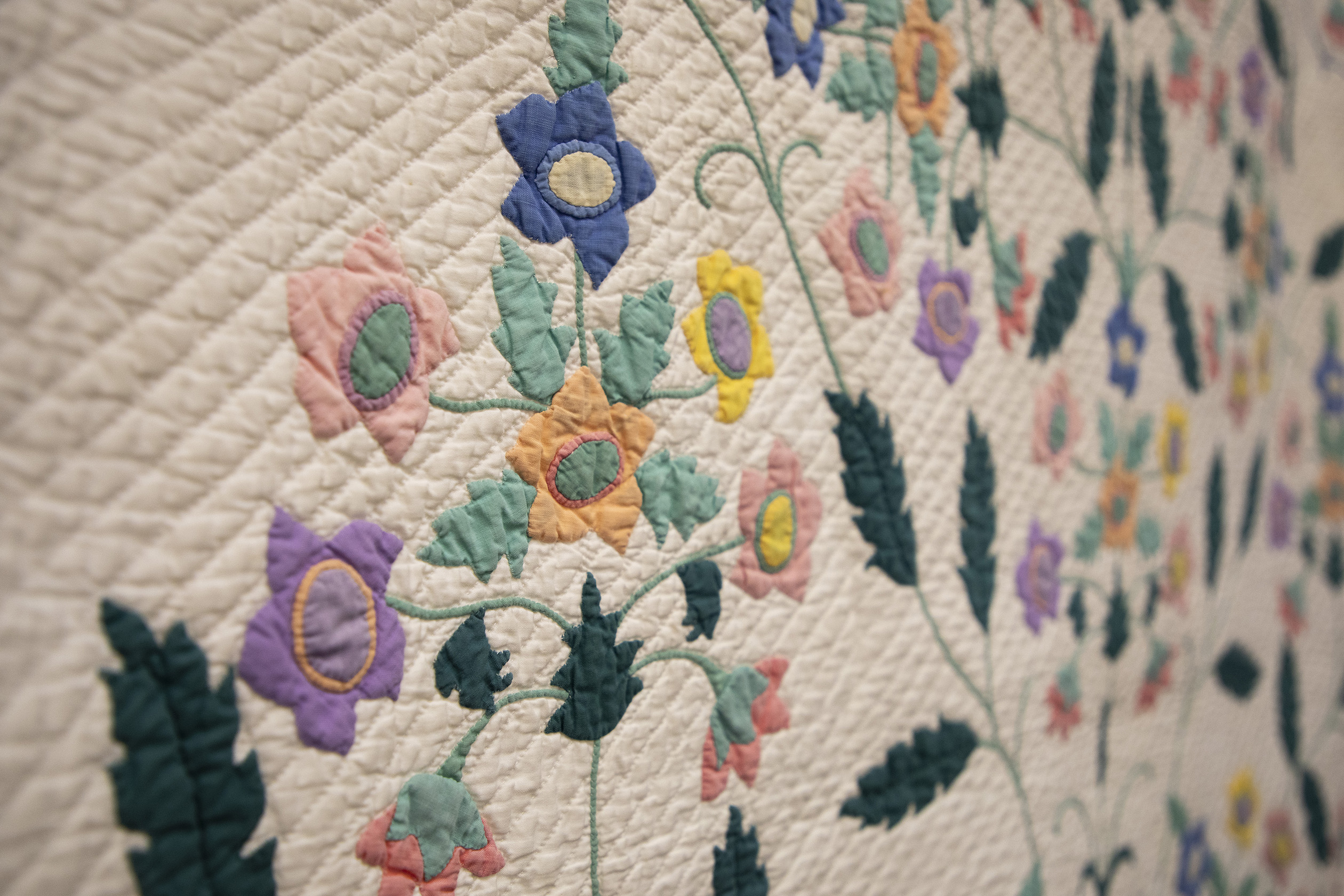A classroom with long, wide tables sits in the corner of the Dolph Briscoe Center for American History. On each surface is a stack of quilts faded with age. Vibrant blues have turned into dingy blue-greens, and whites have aged to look faintly coffee-stained. Some look fluffy, plush and relatively untouched, while others are thin or flat from use. Around the edges of the room hang larger quilts dating from as far back as the 1930s to as recent as the 2010s. Yet more from as early as the 1800s are kept safe and out of sight, protected by the center’s staff. Each quilt tells a story through the fabric, design and technique.
Quilting has persisted through time to bring people, primarily women, together. One of the more popular quilts in the collection, Block Challenge No. 1, is an example of the unifying power of quilts throughout history. This piece began with a single square. The first block was made by Karen Nyberg, an astronaut on board the International Space Station in 2013. After sharing her work from outer space, she received a global response from fellow quilters.
“(Quilts are) collections of women’s stories,” says Jill Morena, the center’s registrar for exhibits and material cultures. “Men do quilt, but historically, even now, it’s a woman’s endeavor.”
The center holds the Winedale Quilt Collection, consisting of 900 parcels spanning two centuries. Ima Hogg, daughter of Jim Hogg, governor in the 1890s, was the first woman to donate. Since then, subcollections were classified to delineate donors, origins and eras.
“(Hogg) was really interested in preserving the work of craftspeople in Central Texas,” Morena says. “That included furniture, cabinetmakers, toolmakers — just really all the material culture of that time, namely the 19th century, and so quilts were part of that.”

Hogg’s collection includes one of the center’s rarest quilts, the Le Moyne Stars Crib Quilt. The piece, about the size of a pizza box and from between 1830 and 1850, contains fabric patterns including flowers, stars and polka dots. Military symbols, such as a rifle and an anchor in beige and brown, are stitched alongside softer imagery. There’s also a banner with a lone star and the word “Texas” printed onto the fabric. It was most likely made to commemorate Texas’ independence or its annexation into the U.S. Katherine Adams, former curator of the collection, says by examining fabrics such as the rare pattern on the Le Moyne quilt, historians gain a sense of time, place and purpose.
“It is a scrap quilt,” Morena says. “Fabric, especially in the 19th century, was usually expensive and valuable, so you would either use it all or reuse it.”
A recent acquisition, the Colonial History Quilt, was stitched from a quilt kit purchased in the early 20th century. It’s a patchwork of white boxes with blue borders. Each square is embroidered with imagery from the discovery of America up to the American Revolution, showing American and European ships, conquistadors, pioneers and even the original flag of the 13 colonies. The kit was sold in the 1930s as a reinterpretation of the war by designer and entrepreneur Ruby Short McKim, who turned her household pastime into a business. McKim studios became a mail-order business that sold quilt patterns and supplies, as well as kits to amateur quilters. She later published quilt and block designs in newspapers and eventually an instructional book on quilting patterns. What Julia Child was to French cuisine, McKim was to quilting.
The kit “really opened up quiltmaking to a lot of people, and also women were able to broadcast their craft to a wider audience and build a business,” Morena says.
I think when you collect and exhibit or use your curriculum quilts, you’re teaching women’s history because it really is about women’s stories.
In 2013, after Nyberg shared her quilting square from outer space, the founders and organizers of the International Quilt Festival issued a challenge for enthusiasts to submit star-themed patchwork patterns and blocks to finish a large communal quilt and show the astronaut that she was not alone. They ended up receiving over 2,000 submissions. Quiltmakers across the world, including Russia, Northern Ireland and Israel, entered the challenge. The fabric submissions created 28 quilts worldwide, all preserved at the Briscoe under the title “Astronomical Quilts! Block Challenge Collection” since 2015.
The collection is still growing. Morena and the Briscoe staff members hope to continue preserving quilts to learn more about women through handcrafted snapshots of history.
“That’s one of the most important aspects. If we’re able to get that information, it just really (shows) the experience of the maker,” Morena says. “I think when you collect and exhibit or use your curriculum quilts, you’re teaching women’s history because it really is about women’s stories.”











